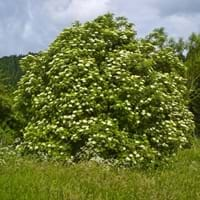Life Span
Perennial
Perennial
Type
Grass
Flowering Plants, Fruits, Herbs, Shrubs
Origin
North America, Europe, Asia
Australia, South America
Types
Bigleaf hydrangea, Hortensia, Smooth hydrangea, Oakleaf hydrangea, Annabelle
Adams Elderberry, Black Beauty Elderberry, Black Lace Elderberry, Johns Elderberry, Nova Elderberry
Habitat
Forest edges, Hillside, Woods
Farms, Homesteads, Near organic waste disposal
USDA Hardiness Zone
Not Available
4-8
Sunset Zone
2a, 2b, 3a, 3b, 4, 5, 6, 7, 8, 9, 10, 11, 12, 13, 14, 15, 16, 17, 18, 19, 20, 21, 22, 23, 24
2a, 2b, 3a, 3b, 4, 5, 6, 7, 14, 15, 16, 17
Habit
Upright/Erect
Upright/Erect
Flower Color
Blue, Dark Purple, Light Purple, Red, White
White
Flower Color Modifier
Bicolor
Not Available
Fruit Color
Not Available
Purple, Red
Leaf Color in Spring
Dark Green
Green
Leaf Color in Summer
Light Green
Green
Leaf Color in Fall
Dark Green, Gold
Yellow green
Leaf Color in Winter
Gold, Tan
Not Available
Leaf Shape
Oblovate
Compound
Plant Season
Spring, Summer, Fall, Winter
Early Spring
Sunlight
Partial Sun, Partial shade
Full Sun, Part sun
Type of Soil
Clay, Loam, Sand
Loamy, Sandy, Well drained
The pH of Soil
Acidic, Neutral, Alkaline
Slightly Acidic
Soil Drainage
Average
Average
Bloom Time
Early Summer, Summer, Late Summer
Early Spring, Spring
Tolerances
Wet Site, Salt, Soil Compaction
Pollution
Where to Plant?
Container, Ground
Ground
How to Plant?
Seedlings, Stem Planting
Grafting, Seedlings
Plant Maintenance
Medium
Medium
Watering Requirements
Not Available
Requires regular watering, Use Mulches to help prevent water loss during hot and windy weather
In Summer
Average Water
Lots of watering
In Spring
Moderate
Moderate
In Winter
Average Water
Average Water
Soil pH
Not Available
Slightly Acidic
Soil Type
Not Available
Loamy, Sandy, Well drained
Soil Drainage Capacity
Not Available
Average
Sun Exposure
Not Available
Full Sun, Part sun
Pruning
Remove damaged leaves, Remove dead branches, Remove dead leaves
Cut or pinch the stems, No pruning needed in the early stages, Prune for shortening long shoots, Prune if you want to improve plant shape, Prune in winter, Prune ocassionally, Remove deadheads
Fertilizers
All-Purpose Liquid Fertilizer
All-Purpose Liquid Fertilizer
Pests and Diseases
Red blotch
Canker, Leaf spot, Powdery mildew, Stem spot, Tomato Ringspot Virus
Plant Tolerance
Wet Site, Salt, Soil Compaction
Drought
Flower Petal Number
Single
Single
Foliage Texture
Fine
Medium
Foliage Sheen
Not Available
Matte
Invasive
Not Available
Sometimes
Self-Sowing
Not Available
No
Attracts
Bees, Flies
Birds
Allergy
Chest tightness, Diarrhea, Dizziness, Nausea, Vomiting
Diarrhea, Nausea, Vomiting
Aesthetic Uses
Not Available
Not Used For Aesthetic Purpose
Beauty Benefits
Not Available
Not Available
Edible Uses
Not Available
Yes
Environmental Uses
Air purification
Air purification
Medicinal Uses
Fever, Kidney problems, Urinary tract problems
constipation, Fever, Heart problems, High cholestrol, HIV/AIDS, Nerve pain, swine flu
Part of Plant Used
Flowers, Root
Flowers, Fruits
Other Uses
Not Available
Not Available
Used As Indoor Plant
Not Available
No
Used As Outdoor Plant
Yes
Yes
Garden Design
Not Available
Not Available
Botanical Name
DESCHAMPSIA cespitosa
Sambucus nigra
Common Name
Tufted Hairgrass
Elderberry
In Hindi
Hydrangea
Elderberry
In German
Hortensie
Holunderbeere
In French
Hortensia
Sureau
In Spanish
Hortensia
Saúco
In Greek
υδραγεία
Elderberry
In Portuguese
Hortênsia
Sabugueiro
In Polish
Hortensja
Bez czarny
In Latin
Hibiscus
Elderberry
Phylum
Not Available
Magnoliophyta
Class
Not Available
Magnoliopsida
Order
Not Available
Dipsacales
Family
Not Available
Adoxaceae
Genus
Not Available
Sambucus
Clade
Not Available
Angiosperms, Asterids, Eudicots
Tribe
Not Available
Not Available
Subfamily
Not Available
Not Available
Number of Species
Not Available
Importance of Tufted Hairgrass and Elderberry
Want to have the most appropriate plant for your garden? You might want to know the importance of Tufted Hairgrass and Elderberry. Basically, these two plants vary in many aspects. Compare Tufted Hairgrass and Elderberry as they differ in many characteristics such as their life, care, benefits, facts, etc. Every gardener must at least have the slightest clue about the plants he wants to plant in his garden. Compare their benefits, which differ in many ways like facts and uses. The medicinal use of Tufted Hairgrass is Fever, Kidney problems and Urinary tract problems whereas of Elderberry is constipation, Fever, Heart problems, High cholestrol, HIV/AIDS, Nerve pain and swine flu. Tufted Hairgrass has beauty benefits as follows: Not Available while Elderberry has beauty benefits as follows: Not Available.
Compare Facts of Tufted Hairgrass vs Elderberry
How to choose the best garden plant for your garden depending upon its facts? Here garden plant comparison will help you to solve this query. Compare the facts of Tufted Hairgrass vs Elderberry and know which one to choose. As garden plants have benefits and other uses, allergy is also a major drawback of plants for some people. Allergic reactions of Tufted Hairgrass are Chest tightness, Diarrhea, Dizziness, Nausea and Vomiting whereas of Elderberry have Diarrhea, Nausea and Vomiting respectively. Having a fruit bearing plant in your garden can be a plus point of your garden. Tufted Hairgrass has no showy fruits and Elderberry has no showy fruits. Also Tufted Hairgrass is not flowering and Elderberry is flowering. You can compare Tufted Hairgrass and Elderberry facts and facts of other plants too.




